![[Incredible Edibles] cover](https://depts.washington.edu/hortlib/graphix/incredibleedibles.jpg)
My favorite publisher of travel guides is DK (Dorling Kindersley Limited). They do very well with gardening books, too, creating visually rich yet uncluttered plant encyclopedias.
A new favorite in this style is Incredible Edibles: Grow Something Different in your Fruit and Veg Plot. The use of the term “veg” is a clue that the author, Matthew Biggs, is British, but he writes for a global audience. But no worries, most of these edibles will do well in a Seattle garden.
Here is the opportunity to expand your palate. While many of the plants are exotic, others are already familiar to gardeners. Fuchsia berries, daylily flowers, and the leaves and flowers of your hosta border all provide tasty treats. Most surprising (for me) was learning that dahlias are edible.
The author typically points out the horticultural value of his subjects and has a knack for taste-tingling imagery. He describes Chilean guava (Ugni molinae) as being a favorite of Queen Victoria because the fruits have little crowns. In addition, “the aromatic fruits are the size of blackcurrants, but taste like wild strawberries and bubblegum. It really should be more widely grown.”
Northwest natives, such as camas and Oregon grape, are included. Never taken a class on cooking camas? A sidebar of “cook’s tips” will get you started. We purchased this fun book with a grant from the Washington State Nursery and Landscape Association.
Published in the July 2018 Leaflet, Volume 5, Issue 7.
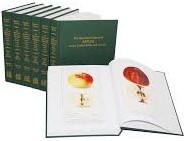 “The Illustrated History of Apples in the United States and Canada” is a seven-volume set with description of all apples found in North American publications through 2000. The information will have immense importance to any pomology researcher, but the more casual reader will find pleasure in the beautiful images: 1,400 watercolors created by artists employed by the United States Department of Agriculture from 1886-1942.
“The Illustrated History of Apples in the United States and Canada” is a seven-volume set with description of all apples found in North American publications through 2000. The information will have immense importance to any pomology researcher, but the more casual reader will find pleasure in the beautiful images: 1,400 watercolors created by artists employed by the United States Department of Agriculture from 1886-1942.
Excerpted from the Summer 2018 Arboretum Bulletin.
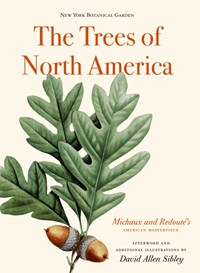 “The Trees of North America” is an excellent new book and winner of one of the three book awards given by the AHS in 2018. Who is the author? It’s complicated.
“The Trees of North America” is an excellent new book and winner of one of the three book awards given by the AHS in 2018. Who is the author? It’s complicated.
The short answer is François-André Michaux (1770-1855) and Thomas Nuttall (1786-1859) with considerable help from skilled engravers, the most famous being Pierre-Joseph Redouté (1759-1840). Their collective publications span the first half of the 19th century, produced in both France and the United States, and first in French and later in English. The full bibliographic story is in the preface of this new book.
The New York Botanical Garden (NYBG) in their LuEsther T. Mertz Library has perhaps the most complete collection of the (at least) 16 different editions by Michaux and Nuttall. Mertz Library staff have produced this new book, using faithful reproductions of the plates. The horticulture staff for NYBG add notes with current updates of nomenclature, ranges, and horticultural uses.
Enough words. This is mostly a picture book, but what a glorious one it is. We are fortunate to have an 1857-1865 original in the Miller Library rare book collection. While a reprint can never quite match a hand-colored original, this comes very close.
These accurate images made the original the standard reference book for North America trees until the early 20th century. A concluding essay by David Allen Sibley explains the process of making the reprinted images – a process as complex as the authorship. Sibley declares, “The end results are beautiful, and the prints are true works of art on their own, but they are different from the originals.”
Excerpted from the Summer 2018 Arboretum Bulletin.
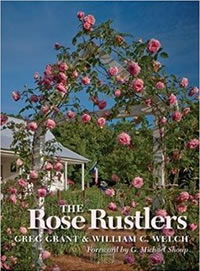
“The Rose Rustlers” is a fun book, a bit of a garden journal, a bit diary mixed with a family photo album. Nominated for an AHS award, the authors Greg Grant and William Welch take turns sharing their stories, their favorite plants (mostly roses), and their favorite people.
Their heroes are a dedicated group promoting old roses, many of the plants surviving with no care in cemeteries or abandoned home sites throughout Texas. While this is a very different climate from ours, every gardener will appreciate the tenacity of plants that are good-doers and the humans that cherish them.
One quirk of this book is the nomenclature. Rose variety names in single quotation marks are cultivars, the same as with most plants. Other varieties have double quotation marks, meaning these are study names. These substitute for real names that have been lost in time. No quotation marks means this rose is legendary and needs no further clarification, including “popular roses like the butterfly rose, the sweetheart rose, and the green rose.”
There is a lot of good horticultural advice and garden design in this book, but best are the stories. The “Air Conditioner Rose”, was name because Grant’s first planting of it covered unsightly equipment. It also survived being under salt water for two weeks after Hurricane Katrina. A suckering rose in Scottsville, Texas has possibly survived since 1834. The magenta flowers are sometimes flushed with blue edges.
These roses are resilient. “Roses didn’t start out as wimpy flowers. Humans did that to them. In addition to being beautiful in a simplistic way, roses were initially wiry and mean as snakes. This made them perfect Texans, of course. If an antique rose is still around, it’s because it’s tough and because it’s pretty.”
Excerpted from the Summer 2018 Arboretum Bulletin.
 The Masters of Modern Landscape Design is a series of biographies featuring landscape architects prominent in the mid to late 20th century in North America. Ruth Shellhorn (1909-2006) was a west coast landscape architect, who lived productively into her 90s. This biography is written by Kelly Comras, a landscape architect based in Los Angeles. Much of Shellhorn’s work was also in greater Los Angeles, but she attended what is now Oregon State University for her undergraduate degree.
The Masters of Modern Landscape Design is a series of biographies featuring landscape architects prominent in the mid to late 20th century in North America. Ruth Shellhorn (1909-2006) was a west coast landscape architect, who lived productively into her 90s. This biography is written by Kelly Comras, a landscape architect based in Los Angeles. Much of Shellhorn’s work was also in greater Los Angeles, but she attended what is now Oregon State University for her undergraduate degree.
Comras observes that if Shellhorn had made a greater effort of self-promotion, she would be more famous today. She quotes David Streatfield, a landscape architecture historian at the University of Washington, who “noted the ‘terrible imbalance in terms of the public’s perception between Ruth Shellhorn…and many of her contemporaries, such as Garrett Eckbo, Lawrence Halprin, and Thomas Church, who wrote books about their own work, hired professional photographers, and published extensively.'”
One of the most fascinating chapters is about Shellhorn’s work on Disneyland. She was hired just four months before the opening in 1955, after Walt Disney belatedly recognized the need to “unify the distinctive elements” of the variously themed areas. She proved very skillful in not only unifying buildings that were already in place but also in creating a visitor experience that increases the sense of discovery while mitigating the challenges of large crowds. Comras describes the landscape design by Shellhorn to be largely intact today despite on-going changes to the park.
Excerpted from the Summer 2018 Arboretum Bulletin.
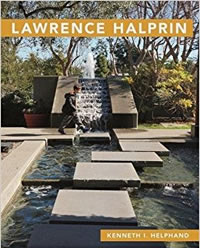 The Masters of Modern Landscape Design is a series of biographies featuring landscape architects prominent in the mid to late 20th century in North America. Lawrence Halprin (1916-2009) was a west coast landscape architect who lived productively into his 90s. He is best known in Seattle for Freeway Park, but he was also responsible for the master landscaping plan for the Seattle World’s Fair, a project he worked on from 1958-1962. Author Kenneth Helphand is a professor emeritus in landscape architecture at the University of Oregon and wrote about “Defiant Gardens: Making Gardens in Wartime” (2007), an award winner which I reviewed in the Spring 2012 “The Bulletin.”
The Masters of Modern Landscape Design is a series of biographies featuring landscape architects prominent in the mid to late 20th century in North America. Lawrence Halprin (1916-2009) was a west coast landscape architect who lived productively into his 90s. He is best known in Seattle for Freeway Park, but he was also responsible for the master landscaping plan for the Seattle World’s Fair, a project he worked on from 1958-1962. Author Kenneth Helphand is a professor emeritus in landscape architecture at the University of Oregon and wrote about “Defiant Gardens: Making Gardens in Wartime” (2007), an award winner which I reviewed in the Spring 2012 “The Bulletin.”
Freeway Park was the first capping of an interstate freeway, a model replicated widely since that time. This biography recounts the initial praise for the project (opened in 1976), the expansion by Halprin associate Angela Danadjieva, the subsequent decline of the park into disuse, and revitalizing revisions to the plantings of the last decade. Before his death, Halprin contributed to this last effort, which leaves the structure of the park in place.
Massive waterfalls are a Halprin signature. I’ve long admired those at Freeway Park but was surprised last summer to discover Forecourt (now Ira Keller) and Lovejoy Fountains in Portland. He designed these in the 1960s and linked them by an eight-block pedestrian mall. “Like all water features they invite attention—and for Halprin, participation.”
He demonstrated this at the dedication of the Forecourt Fountain in 1970. Vietnam War protests at nearby Portland State University created tension between the students and police gathered for the event. Halprin’s words, and even more so his action of walking into the cascading water, helped to calm the crowd and spark a celebration of community.
Excerpted from the Summer 2018 Arboretum Bulletin.
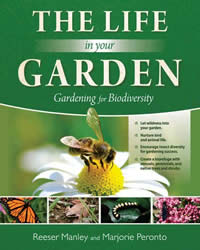 “The Life in Your Garden” has an emphasis on milkweeds, promoting these plants as excellent for overall garden health and biodiversity. Authors Reeser Manley and Marjorie Peronto garden in Maine, but Manley received his PhD in Horticultural Science from Washington State University.
“The Life in Your Garden” has an emphasis on milkweeds, promoting these plants as excellent for overall garden health and biodiversity. Authors Reeser Manley and Marjorie Peronto garden in Maine, but Manley received his PhD in Horticultural Science from Washington State University.
The authors strongly detest the word “pest” but instead see insects and other small garden creatures as pollinators, herbivores, and/or predators. All of these are both good and fascinating. Observing this life has been the source of many realizations for the authors about the positive impact even a small garden can have on its environment.
The book pays special attention to “functional” plants that provide more than just ornamentation, with a special emphasis on understory plants, which “are every bit as important as canopy trees in fostering garden biodiversity.” The lengthy encyclopedia section features east coast natives, but in most cases, western counterparts are found in the appendices. The authors also seek functionality in their annuals and perennials, “creating plantings that sustain garden life from the first emerging bumble bees in late April until the last hoverflies of late September.”
Excerpted from the Summer 2018 Arboretum Bulletin.
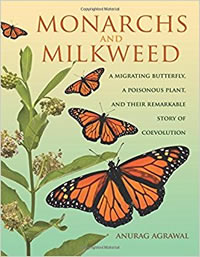 “Monarchs and Milkweed” is like a mystery novel of the highest order. Who will survive? The butterfly or the weed? Even better, this is not fiction!
“Monarchs and Milkweed” is like a mystery novel of the highest order. Who will survive? The butterfly or the weed? Even better, this is not fiction!
Anurag Agrawal’s writing is very compelling. I read the pages of his book as quickly as any whodunit. The characters include the baby caterpillar monarchs, trying to survive their first encounter with their only source of food, the leaves of milkweed. Many do not.
The milkweed plant has many ways to protect itself including its own gooey latex-like sap, or by coaxing monarch predators to do the job. There is good reason for this – the plant gains nothing from its interaction as the adult butterflies are not helpful pollinators.
In contrast, the larval and adult butterflies gain a toxicity that protects them from significant predation by birds. But this toxicity is not effective against other insects or various parasites. The plant seems to know this. The battle of coevolution moves on.
Agrawal is a scientist who interweaves his personal life and research. He discovered the caterpillar of an unknown species, brought it into his living room, watched it pupate, and then emerge from its chrysalis as a butterfly. This was a serendipitous lesson in mimicry as it was a viceroy butterfly, with similar coloration to a monarch and thereby gaining some of its protection, even though it lacks toxicity for birds.
This year’s winner of the CBHL Award of Excellence in Gardening and Gardens, “Monarchs and Milkweed” has wide appeal, even for parts of the country like ours outside of the natural range of monarchs.
Excerpted from the Summer 2018 Arboretum Bulletin.
![[Chinese Medicinal Plants, Herbal Drugs and Substitutes] cover](https://depts.washington.edu/hortlib/graphix/Chinesemedicinalplantsherbaldrugsandsubstitutes.jpg)
“Herbal drug ingredients (materia medica) are pivotal to the practice of herbal Traditional Chinese Medicine (TCM), an integral component of China’s national healthcare system.” After this introduction, the authors of Chinese Medicinal Plants, Herbal Drugs and Substitutes: An Identification Guide discuss the rising global demand for these medicinal plants and their drugs and the need for their proper identification and descriptions in English.
I first read this book with some skepticism. Is it just a well-produced guide to medicines based on folklore? Several facts changed my opinion.
All identified drugs are in the Pharmacopoeia of the People’s Republic of China as compiled by that country’s Ministry of Health. The authors are at two prestigious organizations that worked together for fifteen years on this project. Christine Leon is at the Royal Botanic Gardens, Kew and Lin Yu-Lin is at the Chinese Academy of Medical Sciences. This collaboration and the depth of scholarship convinced me of the academic merit of this work.
This is not a small field guide. Large in physical dimensions and over 800 pages, it is a major reference work describing both the living plants and the harvested and prepared parts used in medicine. The cross-referencing, especially between Chinese and Western traditions, is extensive. I recommend it to anyone working with or interested in traditional Chinese medicine.
Published in the June 2018 edition of Leaflet for Scholars, Volume 5, Issue 6.
![[A New Garden Ethic] cover](https://depts.washington.edu/hortlib/graphix/newgardenethic.jpg)
I recently read and returned a new book to the Elisabeth C. Miller Library: A New Garden Ethic: Cultivating Defiant Compassion for an Uncertain Future by Benjamin Vogt. As I told Laura Blumhagen, this is one of the most important books I have ever read. Bear in mind, I read about 100 nonfiction books a year and I’m not easily impressed. It reminds me of Aldo Leopold’s Sand County Almanac, but I find it even better written. In just 163 pages, it contains a rich world that eloquently presents the complexity of our gardening landscapes and practices. Reading the book feels as if you are speaking with its author, and as if he were a lifelong friend. Part history, part memoir, part genealogy, this book conveys a deep sense of its author and of place. It is so absorbing that I bought a copy for my own collection, anticipating sharing and re-reading it.
The author begins with the exposition of a new garden ethic: moving beyond a preoccupation with beautiful trees and flowers to gardening as if other species and other ecosystems mattered. And, of course, they do, as we are coming to realize rather late in the age of global warming. Our gardens matter, and how we tend them matters. Vogt points out that the new garden ethic goes beyond just planting natives to include the preservation of spaces for birds and insects. His third chapter explains why we believe what we believe about gardening and landscape. The fourth chapter includes a brief but informative overview of historic landscape design and public gardens and parks, offering examples of places that he considers exemplars of a new garden ethic.
The book ends with the challenge and plea to learn new languages, for example, from insects and birds, and to change our gardening practices to move beyond beauty to the support of an entire world, inhabited by many other species. Don’t miss the delight of reading this thought-provoking book!
Published in the June 2018 Leaflet for Scholars, Volume 5, Issue 6.
![[Incredible Edibles] cover](https://depts.washington.edu/hortlib/graphix/incredibleedibles.jpg)
 “The Illustrated History of Apples in the United States and Canada” is a seven-volume set with description of all apples found in North American publications through 2000. The information will have immense importance to any pomology researcher, but the more casual reader will find pleasure in the beautiful images: 1,400 watercolors created by artists employed by the United States Department of Agriculture from 1886-1942.
“The Illustrated History of Apples in the United States and Canada” is a seven-volume set with description of all apples found in North American publications through 2000. The information will have immense importance to any pomology researcher, but the more casual reader will find pleasure in the beautiful images: 1,400 watercolors created by artists employed by the United States Department of Agriculture from 1886-1942. “The Trees of North America” is an excellent new book and winner of one of the three book awards given by the AHS in 2018. Who is the author? It’s complicated.
“The Trees of North America” is an excellent new book and winner of one of the three book awards given by the AHS in 2018. Who is the author? It’s complicated.
 The Masters of Modern Landscape Design is a series of biographies featuring landscape architects prominent in the mid to late 20th century in North America. Ruth Shellhorn (1909-2006) was a west coast landscape architect, who lived productively into her 90s. This biography is written by Kelly Comras, a landscape architect based in Los Angeles. Much of Shellhorn’s work was also in greater Los Angeles, but she attended what is now Oregon State University for her undergraduate degree.
The Masters of Modern Landscape Design is a series of biographies featuring landscape architects prominent in the mid to late 20th century in North America. Ruth Shellhorn (1909-2006) was a west coast landscape architect, who lived productively into her 90s. This biography is written by Kelly Comras, a landscape architect based in Los Angeles. Much of Shellhorn’s work was also in greater Los Angeles, but she attended what is now Oregon State University for her undergraduate degree. The Masters of Modern Landscape Design is a series of biographies featuring landscape architects prominent in the mid to late 20th century in North America. Lawrence Halprin (1916-2009) was a west coast landscape architect who lived productively into his 90s. He is best known in Seattle for Freeway Park, but he was also responsible for the master landscaping plan for the Seattle World’s Fair, a project he worked on from 1958-1962. Author Kenneth Helphand is a professor emeritus in landscape architecture at the University of Oregon and wrote about “Defiant Gardens: Making Gardens in Wartime” (2007), an award winner which I reviewed in the Spring 2012 “The Bulletin.”
The Masters of Modern Landscape Design is a series of biographies featuring landscape architects prominent in the mid to late 20th century in North America. Lawrence Halprin (1916-2009) was a west coast landscape architect who lived productively into his 90s. He is best known in Seattle for Freeway Park, but he was also responsible for the master landscaping plan for the Seattle World’s Fair, a project he worked on from 1958-1962. Author Kenneth Helphand is a professor emeritus in landscape architecture at the University of Oregon and wrote about “Defiant Gardens: Making Gardens in Wartime” (2007), an award winner which I reviewed in the Spring 2012 “The Bulletin.” “The Life in Your Garden” has an emphasis on milkweeds, promoting these plants as excellent for overall garden health and biodiversity. Authors Reeser Manley and Marjorie Peronto garden in Maine, but Manley received his PhD in Horticultural Science from Washington State University.
“The Life in Your Garden” has an emphasis on milkweeds, promoting these plants as excellent for overall garden health and biodiversity. Authors Reeser Manley and Marjorie Peronto garden in Maine, but Manley received his PhD in Horticultural Science from Washington State University. “Monarchs and Milkweed” is like a mystery novel of the highest order. Who will survive? The butterfly or the weed? Even better, this is not fiction!
“Monarchs and Milkweed” is like a mystery novel of the highest order. Who will survive? The butterfly or the weed? Even better, this is not fiction!![[Chinese Medicinal Plants, Herbal Drugs and Substitutes] cover](https://depts.washington.edu/hortlib/graphix/Chinesemedicinalplantsherbaldrugsandsubstitutes.jpg)
![[A New Garden Ethic] cover](https://depts.washington.edu/hortlib/graphix/newgardenethic.jpg)